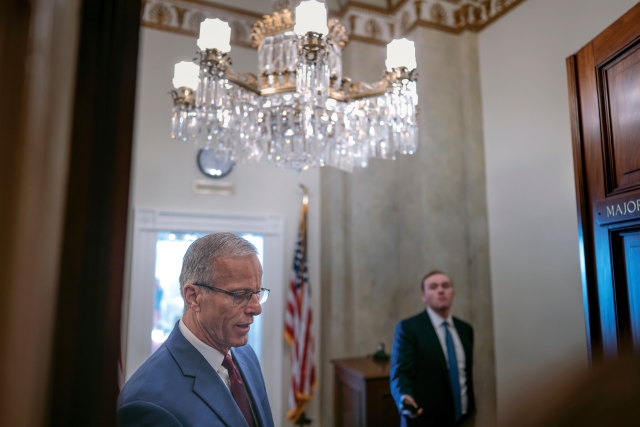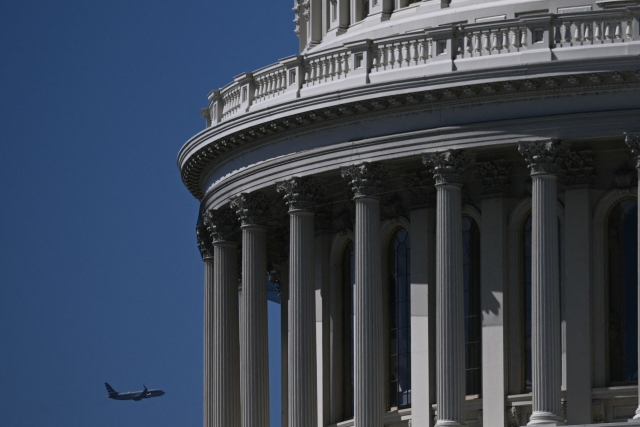For the first time in nearly seven years, the U.S. federal government entered a partial shutdown on October 1, after Congress failed to pass a temporary funding bill. The federal budget deadlock stems from Democratic criticism that the Republican-proposed temporary funding bill neglects healthcare priorities, with Democrats insisting must include additional medical subsidies—a demand Republicans have rejected. With no signs of compromise in Congress, it remains unclear how long this government shutdown will last.
In an immediate and unprecedented escalation, the Trump administration moved to weaponize the crisis, following through on its threat to target political opponents. The White House froze approximately $26 billion in funds destined for Democratic-leaning states, including $18 billion for transit projects in New York and $8 billion for green-energy initiatives across 16 states.

Senate Majority Leader John Thune speaks to reporters as he returns to his office in the Capitol after a vote to end the government shutdown failed.
Deepening the crisis, the administration has signaled plans to initiate mass layoffs of federal workers—a sharp departure from previous shutdowns where employees were temporarily furloughed. This move threatens to permanently reshape the federal workforce and intensifies a partisan battle with no clear end in sight.
According to Dr. Anthony Moretti, an associate professor of communication at Robert Morris University, the administration's approach represents a dangerous escalation. "This isn't just about budget disagreements—it's about weaponizing the shutdown to punish political foes," he said. "The administration is using ordinary Americans as pawns in a high-stakes political game that breaks with all historical precedents."
How the White House leverages the shutdown
The administration's actions represent an unprecedented use of shutdown authority to advance political goals. White House Budget Director Russell T. Vought described the frozen funds as "Green New Scam funding" and wasteful spending, while Vice President JD Vance warned that permanent layoffs could follow if the shutdown persists.

People walk down the steps of the National Archives, closed due to the U.S. government shutdown, in Washington, DC, on October 1, 2025.
The administration showed no signs of backing down, with President Trump declaring on Truth Social that "billions of dollars can be saved" through the funding cuts.
Democratic leaders reacted with fury to the targeted funding cuts. Senate Majority Leader Chuck Schumer accused the administration of using "blackmail" tactics. "He is using the American people as pawns, threatening pain on the country as blackmail," Schumer said of the president.
House Minority Leader Hakeem Jeffries noted that the funding freeze for New York transit projects would throw thousands out of work, while revealing that Democrats had received no communication from the White House since Monday's failed negotiations.
Even some Republicans expressed concern about the administration's approach. Senator Thom Tillis warned that freezing infrastructure funds could "create a toxic environment" that might prolong the shutdown.
Dr. Moretti observed that the situation reflects deeper structural problems. "What we're witnessing is the breakdown of governance norms," he said. "When shutdowns become weapons rather than accidents, the system itself is in crisis."
The heavy cost to bear for the country
The practical consequences of the shutdown spread rapidly across government services. Some 750,000 federal workers were ordered not to work, while essential personnel, including troops and Border Patrol agents, worked without pay. The State Department's consular offices and immigration services will slow down or even close, significantly prolonging processing times for passports, green cards, and visas. The U.S. Patent and Trademark Office began laying off staff, while the Department of Veterans Affairs said it would continue burials but cease maintaining gravesites.

Passengers walk through security lines at Reagan National Airport on the first day of the U.S. government shutdown in Arlington, Virginia, on October 1, 2025.
The administration's threat of permanent layoffs marked a significant departure from previous shutdowns, where workers typically received back pay once funding resumed.
This marks the 22nd government shutdown since 1976, revealing the institutional flaws in fiscal power struggles amid heightened political polarization. The U.S. federal government's operational funding relies entirely on Congress's annual budget appropriations, with each fiscal year running from October 1 to September 30 of the following year.
Analysts widely believe the government shutdown could cost the U.S. economy approximately $7 billion per week. The current shutdown represents the 15th since 1981, but experts note crucial differences in how the Trump administration is handling it. "Previous shutdowns were seen as political failures—now it's being treated as a political opportunity," Dr. Moretti noted. "The administration isn't just managing a crisis; they're actively exploiting it."
The longest previous shutdown in 2018-2019 lasted 35 days and ended only after air traffic disruptions forced a resolution. The current standoff shows signs of being equally protracted, with both sides digging in for a prolonged battle.
What comes next?
The standoff between the White House and Congress continues. Senate Republicans have scheduled another procedural vote for October 1 on both the Republican temporary funding bill and the Democratic proposal.
However, with the Senate failing to pass either Republican or Democratic spending bills, and communication between the parties effectively frozen, the path forward remains unclear. The administration's decision to target Democratic states with funding cuts has intensified partisan animosity, making compromise increasingly difficult.

An airplane flies near the U.S. Capitol on the first day of the U.S. government shutdown in Washington, DC, on October 1, 2025.
Dr. Moretti warned that the consequences could extend far beyond the immediate crisis. "Every day this continues, it does lasting damage to public trust in government institutions," he said. "We're not just testing the limits of the budget process—we're testing the limits of democratic governance itself."
As both sides prepare for a protracted fight, the American public faces the prospect of extended service disruptions and economic uncertainty, with no clear resolution in sight.
Reporter: Guo Zedong
Photo: CFP
Editor: Yuan Zixiang, James Campion, Shen He
















